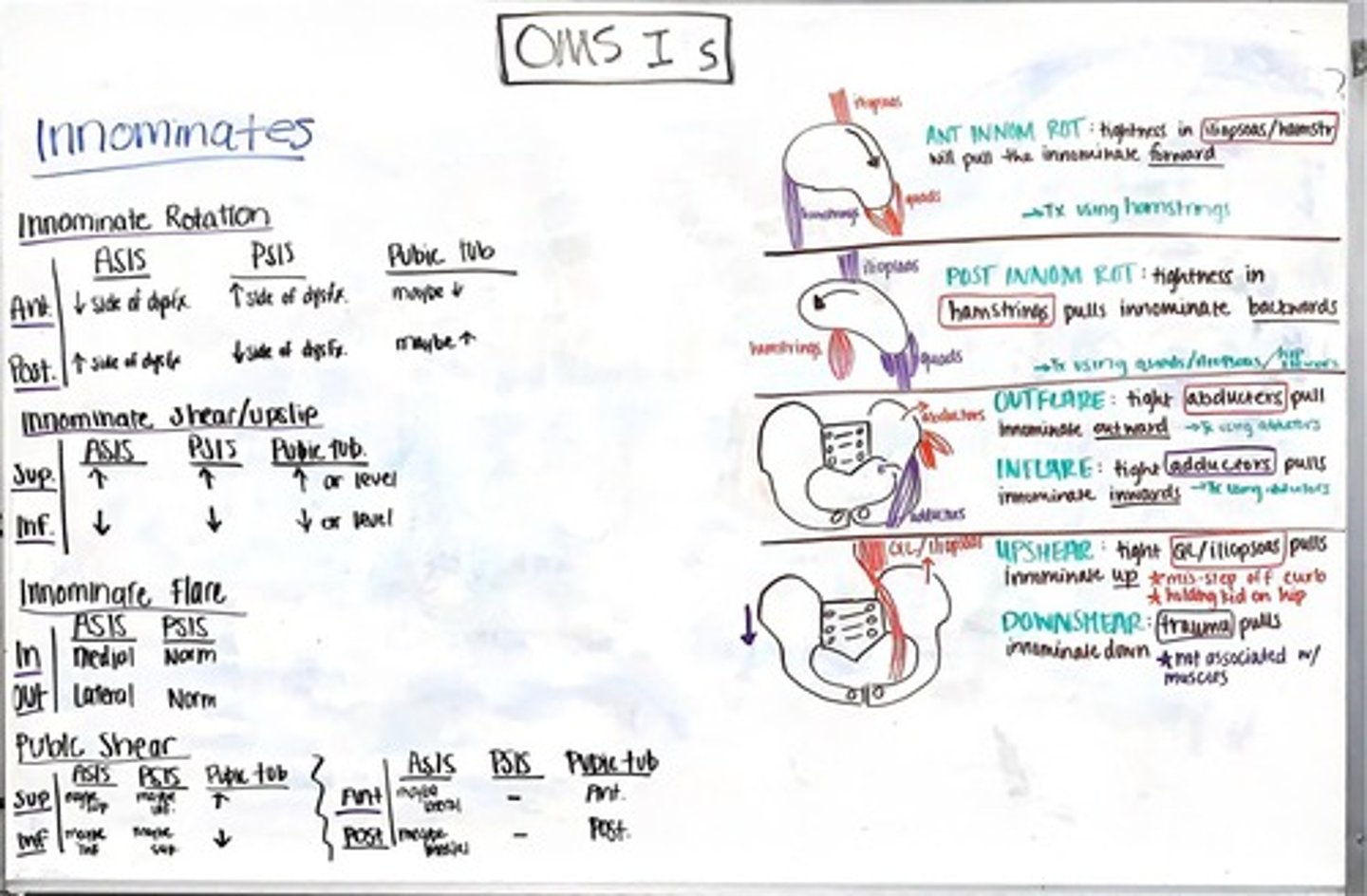EPC/OPP/FMHC Exam 3/2
1/168
There's no tags or description
Looks like no tags are added yet.
Name | Mastery | Learn | Test | Matching | Spaced |
|---|
No study sessions yet.
169 Terms
Innominates
Pelvic bones that articulate with the sacrum.

Whats happening in an anterior innominate rotation?
Tightness in iliopsoas/hamstring, will pull the innominate FORWARD
How do you treat an anterior innominate rotation?
Tx using hamstrings
Whats happening in a posterior innominate rotation?
Tightness in hamstrings, pulls innominate backwards
How do you treat a posterior innominate rotation?
Using Quads, iliopsoas, hip flexors
Whats happening in an innominate outflare?
Tight abductors pull innominate outward
How do you treat an innominate outflare?
Adductors
Whats happening in an innominate inflare?
Tight adductors pulls innominate inwards
How do you treat an innominate inflare?
Abductors
Whats happening in an innominate upshear?
Tight GL/iliopsoas pulls innominate up
How do you get an innominate upshear?
Misstep off curb, Trendelenburg gait
Holding child on hip
Whats happening in an innominate downshear?
Trauma pulls innominate down
Not associated with muscles
Oblique Axis
Axis around which sacral torsion occurs.
Seated Flexion Test
Assessment for sacral somatic dysfunction.
Sacral Torsion
Rotation of the sacrum around an axis.
L5 Dysfunction
Lumbar vertebra dysfunction affecting sacral movement.
Bilateral Sacral Dysfunction
Dysfunction affecting both sides of the sacrum.
Forward Torsion
Sacrum rotates in the same direction as L5.
Backward Torsion
Sacrum rotates opposite to L5 rotation.
Spring Test
Test for sacral resistance to anterior force.
Deep Sacral Sulcus
Indicates sacral rotation direction.
Inferior ILA
Inferior lateral angle of the sacrum.
Type I Dysfunction
Neutral dysfunction with no rotation.
Type II Dysfunction
Non-neutral dysfunction with rotation present.
Mitchell Model
Describes relationship between L5 and sacrum rotation.
Lateral Recumbent Position
Position for treating backward torsions.
Modified Sims' Position
Position for treating forward torsions.
Respiratory Assistance
Technique used in muscle energy treatment.
Sacral Flexion Dysfunction
Inability of sacrum to flex properly.
Sacral Extension Dysfunction
Inability of sacrum to extend properly.
L5 Translation
Movement of L5 relative to sacrum.
Right Oblique Axis
Axis for right-sided sacral torsion.
Left Oblique Axis
Axis for left-sided sacral torsion.
Bilateral Extension
Sacrum extended bilaterally during movement.
Flexion/Extension
Movements of sacrum during respiratory cycles.
Asymmetry of Deep Sacrum
Unequal depth of sacral sulci indicating dysfunction.
Positive Seated Flexion Test
Indicates sacral dysfunction on tested side.
Negative Seated Flexion Test
No dysfunction indicated on tested side.
Sacrum Rotation
Movement of sacrum around its axes.
L5 Rotation
Rotation of lumbar vertebra affecting sacrum.
Dysfunction Diagnosis
Identifying specific dysfunctions in sacrum and L5.
Right on Right Torsion
Anterior sacral torsion with lumbar dysfunction.
Muscle Energy Technique
Treatment method using patient's muscle contractions.
Inferior Pubic Shear
Pelvic dysfunction with ASIS and PSIS findings.
Anterior Innominate Rotation
Pelvic rotation causing anterior tilt of innominate.
Standing Flexion Test
Assessment for iliosacral dysfunction laterality.
Superior Pubic Shear
Pelvic dysfunction with superior ASIS and inferior PSIS.
Left Superior Innominate Shear
Left leg abducted and internally rotated during treatment.
Left Inferior Innominate Shear
Left leg placed on physician's leg for treatment.
Left Posteriorly Rotated Innominate
Left leg hanging off table for stabilization.
Left Anteriorly Rotated Innominate
Left leg flexed over physician's shoulder for treatment.
Innominate In-flare
Knee and hip flexed, abduction applied by physician.
Innominate Out-flare
Knee and hip flexed, adduction applied by physician.
Superior Innominate Shear Muscles
External obliques, iliocostalis, longissimus activated.
Inferior Innominate Shear Muscles
Gluteus medius and maximus activated during treatment.
Innominate Out-Flare Muscles
Tensor fascia lata causes lateral pelvic pull.
Innominate In-Flare Muscles
Tight iliacus causes anterior pelvic pull.
Posterior Innominate Rotation Muscles
Tight hip extensors originating from ischial tuberosity.
Anterior Innominate Rotation Muscles
Tight hip flexors causing anterior pelvic rotation.
Pubic Dysfunction
Imbalance between abdominal and adductor muscles.
Reciprocal Inhibition
Agonist contraction allows antagonist relaxation.
Joint Mobilization
Restoring joint mechanics to relieve muscle tension.
Contralateral Swinging
Movement of opposite leg during sacral rotation.
Lumbar Dysfunction
Spinal dysfunction from L1 to L5 affecting sacrum.
Hamstring Syndrome
Pain in posterior thigh due to muscle tightness.
Sacroiliac Joint Dysfunction
Pelvic joint dysfunction causing low back pain.
Sciatic Nerve Irritation
Pain caused by compression of the sciatic nerve.
Deep Vein Thrombosis
Blood clot in deep veins causing leg pain.
Rectus Abdominis
Vertical muscle in the abdominal wall.
External Abdominal Oblique
Superficial muscle aiding trunk rotation.
Internal Abdominal Oblique
Deeper muscle assisting trunk flexion.
Pectineus
Muscle involved in hip flexion and adduction.
Adductor Brevis
Short muscle aiding hip adduction.
Adductor Longus
Long muscle assisting in hip adduction.
Adductor Magnus
Large muscle facilitating hip adduction.
Gracilis
Thin muscle aiding hip adduction and flexion.
Caudad
Directional term meaning inferior or downward.
Cephalad
Directional term meaning superior or upward.
Iliopsoas
Major hip flexor muscle group.
Sartorius
Longest muscle aiding hip flexion and rotation.
Rectus Femoris
Quadriceps muscle involved in knee extension.
Gluteus Maximus
Largest muscle for hip extension and rotation.
Piriformis
Muscle aiding hip external rotation.
Biceps Femoris
Hamstring muscle aiding knee flexion.
Semitendinosus
Hamstring muscle assisting in knee flexion.
Semimembranosus
Hamstring muscle contributing to knee flexion.
Relaxin
Hormone that relaxes pelvic ligaments during pregnancy.
EHR
Electronic Health Record for patient data management.
Clinical Decision Support
Tools providing patient-specific health information.
Discrete Data
Quantifiable data like lab results.
Free Text
Unstructured data like typed notes.
Binary Data
Data in two states, e.g., images.
Direct Cost
Costs directly tied to healthcare resources.
Indirect Cost
Costs from societal losses due to illness.
Intangibles
Costs related to suffering and quality of life.
Opportunity Cost
Benefit lost when choosing one option over another.
Health Microeconomics
Study of healthcare at individual or firm level.
Health Macroeconomics
Study of healthcare at national or international level.
Total Cost
Sum of all expenditures over a time period.
Average Cost
Total cost divided by units produced.